Indwelling Catheters Market Research, 2035
The global indwelling catheters market was valued at $1.5 billion in 2023, and is projected to reach $4 billion by 2035, growing at a CAGR of 8.8% from 2024 to 2035. Rise in incidences of chronic conditions such as diabetes, multiple sclerosis, and spinal cord injuries often necessitates long-term catheter use, boosting the demand for indwelling catheters. For instance, according to an article published by National Center for Biotechnology and Information (NCBI) in 2022, a study in five Middle Eastern countries (Egypt, Turkey, Kuwait, Saudi Arabia, UAE) found the prevalence of moderate-to-severe BPH symptoms to be 13.2% overall, with rates ranging from 10.5% in Egypt to 16.1% in the Gulf cluster countries.
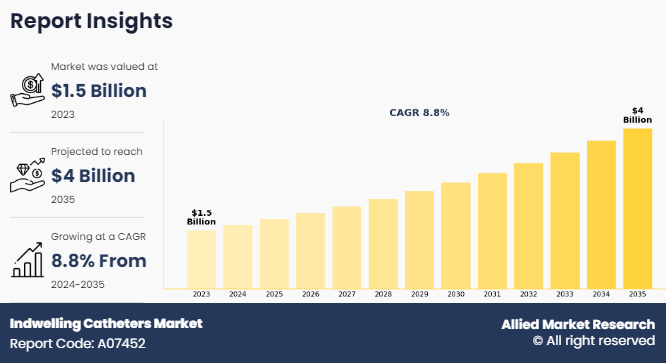
Key Findings
- By product, the 2-way catheters segment was largest contributor to the indwelling catheters market in 2023.
- By coating type, the hydrogel coating segment was largest contributor to the indwelling catheters market in 2023.
- By material, the silicone segment dominated the market in 2023 and is expected to grow at a CAGR during the forecast period.
- By application, the post-surgical care segment was largest contributor to the market in 2023.
- Region-wise, North America generated the largest revenue in 2023. However, Asia-Pacific is anticipated to grow at the highest CAGR during the forecast period.
Indwelling catheters, also known as Foley catheters, are flexible tubes inserted through the urethra into the bladder to drain urine. They are commonly used for patients who cannot empty their bladders on their own due to medical conditions such as urinary retention, severe incontinence, or during and after surgical procedures. The catheter is anchored in the bladder by a small balloon inflated with sterile water, which prevents it from slipping out. The other end of the catheter is connected to a drainage bag that collects the urine. Indwelling catheters come in various sizes and materials, including latex and silicone, to suit different patient needs and reduce the risk of infection and irritation. Regular hygiene practices and periodic replacement are essential for patient safety and comfort.
Market Dynamics
Rise in prevalence of chronic diseases such as diabetes, cardiovascular diseases, and neurological disorders significantly impacts the demand for indwelling catheters. These conditions often result in complications such as bladder dysfunction and urinary retention, necessitating the use of catheters for effective management. The incidence of these diseases continues to increase globally, leading to rise in need for reliable catheter solutions. One of the most significant factors driving the indwelling catheters market is the aging global population. As people age, they are more likely to suffer from conditions requiring catheters, such as urinary retention, benign prostatic hyperplasia (BPH), and other urological disorders.
Fuerthermore, rise in prevalence of chronic diseases such as diabetes and multiple sclerosis, which can lead to bladder dysfunction, is also higher in older adults, further increasing the demand for indwelling catheters. With rise in population for over 65 years old, the need for medical interventions such as catheters is expected to grow correspondingly. For instance, Worldometers, utilizing the most recent data from the United Nations, estimated India's current population to be 1.4 billion as of Wednesday, June 19, 2024. With the average life expectancy rising to 68.4 years, these demographic shifts significantly influence the incidence and patterns of prostate cancer in the country.
In addition, the growing number of surgical procedures globally is another factor boosting the demand for indwelling catheters market. Catheters are often required during and after surgeries to manage urinary functions, especially in procedures involving the lower abdomen, pelvis, and reproductive organs. With increase in the number of surgeries being performed due to rise in healthcare access and advancements in surgical techniques, the need for indwelling catheters is also on the rise. Furthermore, the growing awareness among healthcare providers and patients about the benefits and applications of indwelling catheters further drives the demand for indwelling catheters. Educational initiatives and training programs for healthcare professionals about the proper use and management of catheters have also improved outcomes and reduced complications, encouraging more widespread use. Moreover, improving accessibility to healthcare services in developing regions has expanded the indwelling catheters market forecast.
However, catheter-associated urinary tract infections (CAUTIs), urethral trauma, bladder stones, and catheter blockage are common complications that can arise from long-term catheterization which may limit the adoption of indwelling catheters. These complications not only pose risks to patient health but also increase healthcare costs and lead to longer hospital stays which may restrict the market growth. Moreover, the rise in advancements in catheter design, materials, and manufacturing processes present significant opportunities for indwelling catheters market growth.
Segments Overview
The indwelling catheters market is segmented on the basis of product, coating type, material, application, and region. On the basis of product, the market is divided into 2-way catheters, 3-way catheters, and 4-way catheters. On the basis of coating type, the market is classified into hydrogel coating, silver alloy coating, silicone elastomer, and others. On the basis of material, the market is classified into latex and silicone. On the basis of application, the market is categorized into post-surgical care, critical care, urinary incontinence, and benign prostate hyperplasia. Region-wise, the market is studied across North America (U.S., Canada, and Mexico), Europe (Germany, UK, France, Spain, Italy, and Rest of Europe), Asia-Pacific (China, Japan, India, Australia, and Rest of Asia-Pacific), and LAMEA (Brazil, South Africa, Saudi Arabia, Rest of LAMEA).
By Product
The 2-way catheters segment dominated the indwelling catheters market share in 2023 and is also expected to register the highest CAGR during the forecast period, as these catheters are widely used for their simplicity and effectiveness in draining urine from the bladder, particularly in acute care settings. In addition, advancements in catheter design, such as antimicrobial coatings and improved materials, enhance their performance and reduce the risk of complications, further driving segment growth.
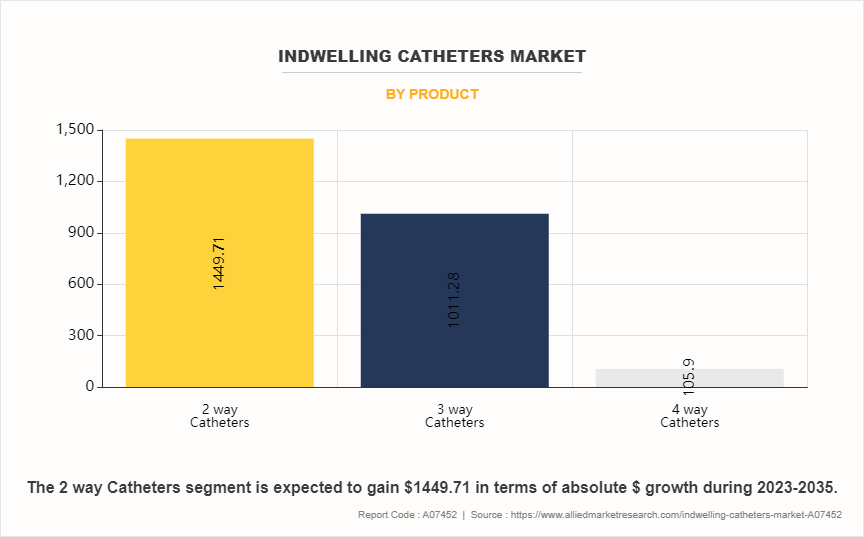
By Coating Type
The hydrogel coating segment dominated the indwelling catheters market share in 2023 and is expected to register the highest CAGR during the forecast period, as hydrogel-coated catheters offer superior biocompatibility, reducing the risk of tissue irritation and infection. In addition, the growing emphasis on infection control measures in healthcare settings and the increasing demand for advanced catheter materials further drive the adoption of hydrogel-coated catheters.

By Material
The silicone segment dominated the indwelling catheters market size in 2023 and is expected to register the highest CAGR during the forecast period. Silicone indwelling catheters offer superior biocompatibility and flexibility, reducing the risk of tissue irritation and discomfort for patients. Their non-reactive nature minimizes allergic reactions and inflammatory responses, making them suitable for long-term use. In addition, silicone catheters are durable and ensure reliable urinary drainage which supports the segment growth. The growing preference for silicone catheters among healthcare providers, coupled with advancements in silicone manufacturing technology, further drives their adoption in the indwelling catheters market.
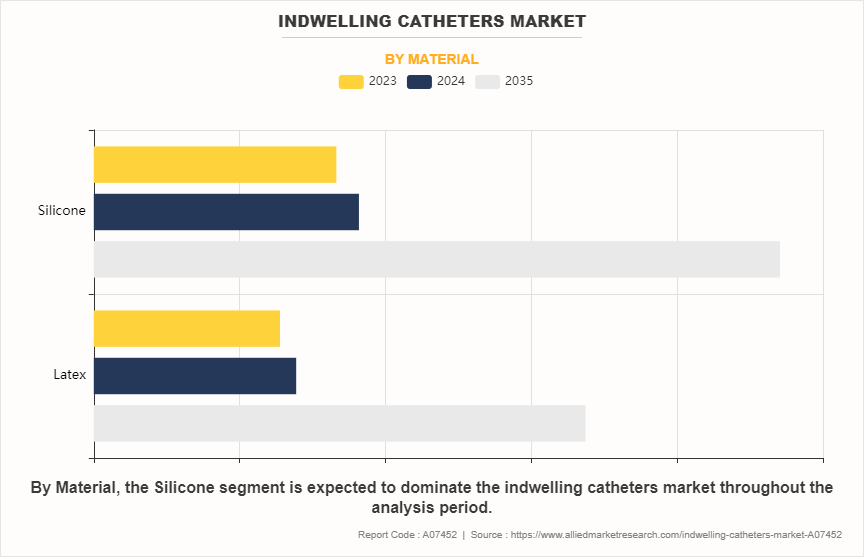
By Application
The post-surgical care segment dominated the indwelling catheters market size in 2023. Post-surgical care typically involves monitoring and maintaining urinary function, which necessitates the use of indwelling catheters to facilitate urine drainage. In addition, advancements in surgical techniques led to increase in surgical procedures globally, further driving the demand for indwelling catheters in post-operative settings. However, the benign prostate hyperplasia segment is expected to register the highest CAGR during the forecast period, owing to rise in prevalence of BPH. In addition, the availability of minimally invasive treatments for BPH, such as transurethral resection of the prostate (TURP) and laser therapy, may lead to temporary post-operative catheterization, boosting the market for indwelling catheters in BPH management.
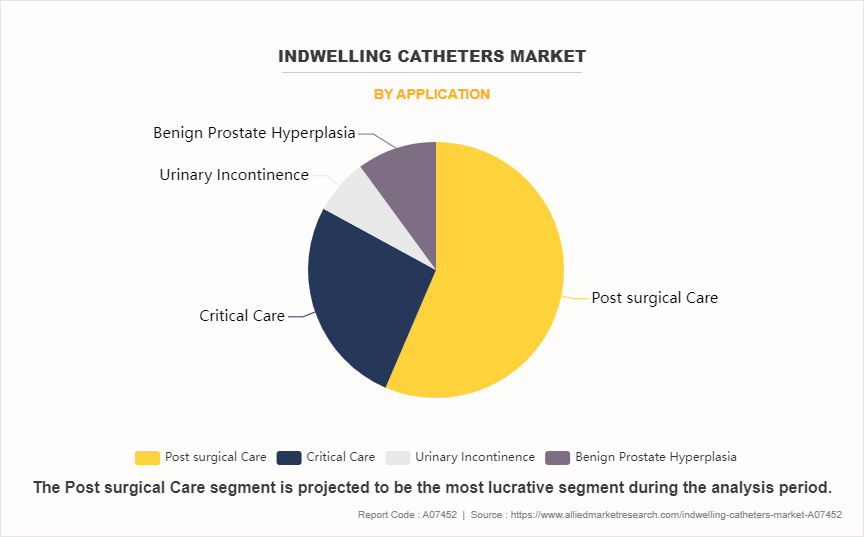
By Region
The indwelling catheters industry is analyzed across North America, Europe, Asia-Pacific, LAMEA. North America accounted for the largest market share in 2023 and is expected to remain dominant during the forecast period. This dominance is attributed to its advanced healthcare infrastructure along with a strong emphasis on technological innovation. Furthermore, the strong presence of key players in the region is further contributing to market growth in the region. However, the Asia-Pacific region is anticipated to register the highest CAGR during the forecast period, owing to rapid economic growth in the region. In addition, rise in investment in healthcare infrastructure and rise in R and D activities drive the indwelling catheters market opportunity.
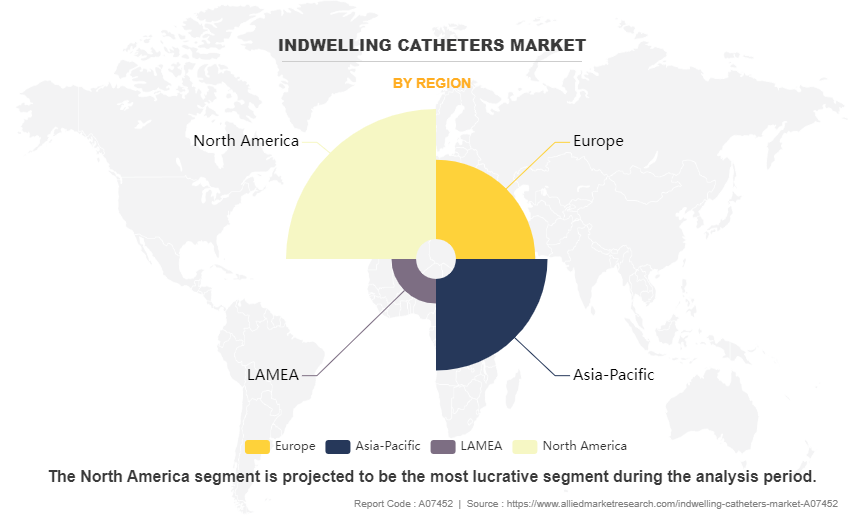
Competitive Analysis
Key players such as Cardinal Health and Coloplast have adopted expansion as key developmental strategies to improve the product portfolio of the indwelling catheters market. For instance, in September 2021, Coloplast opened a new factory in Costa Rica to help those with intimate healthcare needs. The purpose of the factory is to meet the increasing demand for medical devices, including ostomy pouches and catheters by producing and supplying products that will improve the quality of life for many people worldwide.
Recent Developments in the Indwelling Catheters Industry
- In March 2022, Cardinal Health announced plans to build a 574,670 square foot medical distribution center in Columbus, Ohio. The new building is expected to integrate automation and technology to work alongside Cardinal Health employees; improve safety, service and quality; deliver operational efficiencies; and better support fluctuations in volume and labor to provide customers with a predictable and stable customer experience.
- In July 20221, Amsino announced the opening of a new, $32 million North American distribution and manufacturing hub in Aurora, Illinois. This strategic facility, spanning 222,000 square feet, will significantly enhance the company‐™s production and distribution capabilities. With support from state and local officials, Amsino has established this center to house all production and distribution activities for its extensive range of medical devices and products.
Key Benefits for Stakeholders
- This report provides a quantitative analysis of the market segments, current trends, estimations, and dynamics of the indwelling catheters market analysis from 2023 to 2035 to identify the prevailing indwelling catheters market opportunities.
- The market research is offered along with information related to key drivers, restraints, and opportunities.
- Porter's five forces analysis highlights the potency of buyers and suppliers to enable stakeholders make profit-oriented business decisions and strengthen their supplier-buyer network.
- In-depth analysis of the indwelling catheters market segmentation assists to determine the prevailing market opportunities.
- Major countries in each region are mapped according to their revenue contribution to the global market.
- Market player positioning facilitates benchmarking and provides a clear understanding of the present position of the market players.
- The report includes the analysis of the regional as well as global indwelling catheters market trends, key players, market segments, application areas, and market growth strategies.
Indwelling Catheters Market Report Highlights
| Aspects | Details |
| Market Size By 2035 | USD 4 billion |
| Growth Rate | CAGR of 8.8% |
| Forecast period | 2023 - 2035 |
| Report Pages | 394 |
| By Product |
|
| By Coating Type |
|
| By Material |
|
| By Application |
|
| By Region |
|
| Key Market Players | B. Braun SE, Advin Health Care, Sterimed Group, Cardinal Health Inc., Becton, Dickinson, and Company, Coloplast Group, Medline Industries, Inc., Amsino International, Inc., Teleflex Incorporated, Angiplast Pvt. Ltd. |
Analyst Review
According to the insights of CXOs, the global indwelling catheters market is expected to exhibit high growth potential attributable to rise in prevalence of urological diseases, rise in geriatric population, and advancements in medical technology. However, complications associated with indwelling catheters limit the growth of indwelling catheters market.?
CXOs further added that the key players have adopted various strategies to strengthen their foothold in the competitive market. In addition, surge in preference for less invasive medical procedures is boosting the adoption of indwelling catheters, which offer a less intrusive option for managing urinary conditions, thereby further propels the market growth.
Furthermore, North America dominated the market share in 2023, in terms of revenue, owing to high awareness about urological conditions, improved diagnostic capabilities, high healthcare expenditure, and strong presence of key players in this region. However, Asia-Pacific is anticipated to witness notable growth, owing to the aging population, growing healthcare infrastructure, rise in awareness and diagnosis of urological conditions, and supportive government policies
The growth of the indwelling catheters market is driven by increasing prevalence of urinary disorders, advancements in catheter technology improving comfort and reducing infections, expanding elderly population requiring long-term urinary management solutions, and rising healthcare expenditure and awareness across the globe.
The market value of indwelling catheters market in 2035 is $4.0 billion.
North America is accounted for the largest market share in 2023 owing to well established healthcare infrastructure, substantial investments in research and development, and the widespread availability of indwelling catheters products.
The forecast period for indwelling catheters market is 2024 to 2035.
The base year is 2023 in indwelling catheters market.
Becton, Dickinson, and Company, Cardinal Health Inc., Coloplast Group, Medline Industries, Inc., and Teleflex Incorporated held a high market position.
Indwelling catheters are medical devices inserted into the bladder through the urethra or a surgical opening to drain urine continuously.
The total market value of indwelling catheters market is $1.5 billion in 2023.
Loading Table Of Content...
Loading Research Methodology...



